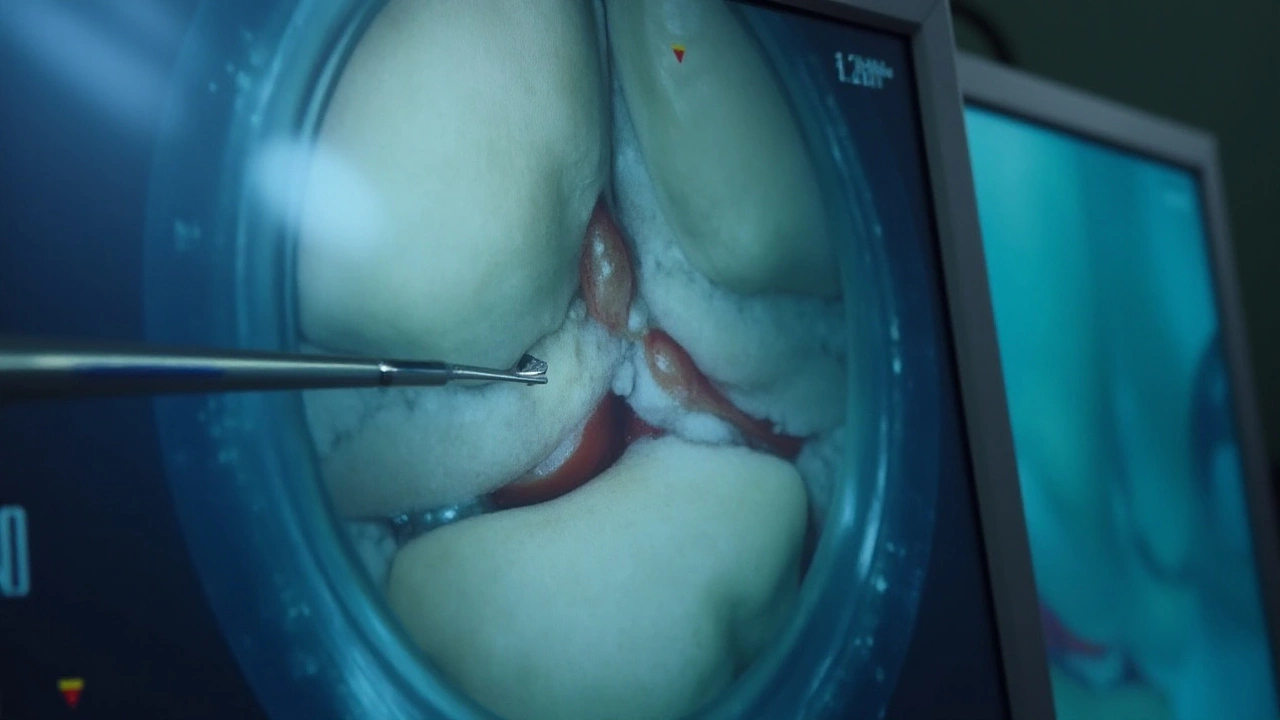Orthopedic surgeries have been at the forefront of medical advances, offering relief and improved mobility to countless individuals facing musculoskeletal challenges. Among the array of procedures available, arthroscopy stands out as the fifth most common orthopedic surgery. This minimally invasive technique is widely favored for treating joint-related issues.
Arthroscopy has transformed the landscape of orthopedic interventions, providing patients with quicker recovery periods and less postoperative discomfort. Particularly effective for knee and shoulder procedures, arthroscopy allows surgeons to repair joint problems through small incisions, using high-tech cameras and precise instruments.
For anyone considering an orthopedic surgery, understanding more about the procedure can help ease anxiety and prepare you for the steps ahead. Whether you're an active individual recovering an old sports injury or someone dealing with the wear and tear of aging joints, knowing about arthroscopy’s impact and benefits can be a crucial element of your journey to recovery.
- Understanding Orthopedic Surgeries
- What is Arthroscopy?
- Common Issues Addressed by Arthroscopy
- Benefits of Minimally Invasive Techniques
- Recovery and Rehabilitation Process
- Tips for a Successful Surgery Experience
Understanding Orthopedic Surgeries
When it comes to maintaining our body's framework, orthopedic surgery plays a crucial role. These procedures are designed to address injuries and disorders of the skeletal system and associated muscles, joints, and ligaments. Whether it's a sports injury or a degenerative disorder, orthopedic surgeries aim to bring relief and restore function to affected areas, enabling individuals to resume their daily activities with minimal hindrance. Interestingly, orthopedic surgeons perform a range of procedures, each tailored to specific conditions, although developments like minimally invasive surgery have transformed patient experiences and outcomes significantly.
Among the myriad techniques, arthroscopy stands out by offering a window into the joint space without extensive surgical exposure. It utilizes an arthroscope, which is essentially a camera inserted into the joint, providing a detailed view of the insides. This advancement is not just about convenience; it's about reducing recovery time and associated risks. In recent years, statistics have shown a consistent increase in the number of arthroscopic surgeries, highlighting their growing importance in the surgical world. The American Academy of Orthopaedic Surgeons has reported that in the United States alone, over 4 million arthroscopies are performed annually, indicating a strong trust and reliance on this procedure among medical professionals.
Modern orthopedic surgeries don't just focus on addressing present issues; they also emphasize enabling the body to heal itself efficiently. Surgeons today blend traditional surgical methods with cutting-edge techniques, such as robotic assistance and 3D-printed implants, making customized care a reality. As Dr. Jonathan Chang, a renowned orthopedic surgeon, once remarked,
"The advances in orthopedic surgery today mean less pain and faster recovery times for patients. We're not just fixing problems; we're enhancing quality of life."His words resonate with those who have experienced the transformative power of these operations, witnessing firsthand how integrating technology can dramatically affect recovery and mobility.
Despite the complex nature of these surgeries, the goal is simple: improving patient health and mobility. This is where the role of comprehensive rehabilitation comes in. From physiotherapy to occupational therapy, the post-surgical journey is integral to a full recovery. Patients often find themselves engaged in tailored exercises aimed at strengthening muscles, improving flexibility, and restoring optimal function. The collaborative effort between the surgeon and rehabilitation specialists ensures that patients are not just treated, but also empowered to regain control over their physical health.
What is Arthroscopy?
The medical field of orthopedics has greatly evolved through the years, with substantial breakthroughs in both understanding and treating joint ailments. Among the remarkable advances is arthroscopy, a technique that revolutionized the way joint conditions are diagnosed and managed. Arthroscopy involves the use of a sophisticated instrument known as an arthroscope, equipped with a camera and light source, enabling surgeons to view the interior of joints without making extensive incisions.
This procedure is commonly employed to investigate symptoms like knee pain, swelling, or stiffness, particularly when X-rays and other imaging don't provide conclusive information. Arthroscopy permits direct visualization of the joint surfaces, and capsule and internal structures. It's largely favored for its minimally invasive nature which significantly reduces the recovery period, allowing patients to resume their normal daily activities much quicker than traditional open surgery would entail. Hence, it’s often the procedure of choice for knee, shoulder, and sometimes elbow or ankle investigations.
Doctors utilize arthroscopy for various procedures, such as repairing ligaments, removing inflamed joint linings, and treating cartilage disorders. It’s a pivotal tool when dealing with active individuals – from athletes experiencing sports injuries to elderly patients suffering from degenerative joint conditions. Indeed, the growing prevalence of healthy lifestyle activities has amplified the demand for such adept procedures that address both sports-induced and age-related joint issues.
In some instances, opinions from orthopedic specialists further underline its effectiveness and widespread adoption in clinical settings.
"Arthroscopy has become an indispensable tool in my practice, offering a nuanced view of joint pathology and enabling precision in treatment," says Dr. John Smith, esteemed orthopedic surgeon at Healthline Center.
In recent years, the number of arthroscopies performed annually has surged, illustrating its critical role in orthopedic care. According to a report by the American Academy of Orthopaedic Surgeons, knee arthroscopies alone accounted for millions of procedures worldwide, suggesting its ubiquity and reliability in medical practice. For patients, understanding the rationale behind such an approach helps demystify the surgical process, granting peace of mind and informed decision-making capability.

Common Issues Addressed by Arthroscopy
Arthroscopy serves as a highly effective option for diagnosing and treating various joint issues, making it an incredibly versatile procedure in the realm of orthopedic surgery. It’s often the go-to choice when patients suffer from joint pain or experience limited movement in crucial areas like the knee, shoulder, elbow, or hip. The remarkable advantage of arthroscopy lies in its capacity to be both diagnostic and therapeutic. Using a tiny camera and specialized surgical instruments inserted through small incisions, surgeons can gain a detailed view of the inner workings of joints. This direct visualization enables them to identify tears, inflammation, and other joint abnormalities with precision.
One of the most common applications of this technique is in addressing knee injuries, particularly joint repair. Athletes often encounter meniscus tears or damage to cartilage due to intense physical activity, making arthroscopy an incomparable tool for swift and effective treatment. The procedure is equally adept at addressing shoulder issues, such as rotator cuff tears, impingement syndrome, and the removal of loose bodies that hinder smooth joint movement. By opting for arthroscopy, patients benefit from less tissue disruption, which not only facilitates rapid recovery but also minimizes postoperative complications.
An intriguing aspect of arthroscopy is its capability to handle diverse conditions beyond repair, such as the synovial tissue inflammation common in rheumatoid arthritis. This procedure effectively reduces symptoms by removing inflamed tissues, offering significant relief to sufferers. According to a study published in the Journal of Knee Surgery, synovectomy via arthroscopy showcases promising results in managing chronic inflammation.
"Arthroscopy has revolutionized how we approach joint disorders, turning what could be debilitating conditions into manageable ones," says Dr. Jane T. Thompson, a leading expert in orthopedic therapies.Patients often find the reduced scarring and shorter hospital stays quite appealing, contributing to the soaring popularity of this minimally invasive method.
Apart from common therapeutic uses, arthroscopy frequently aids in the management of loose cartilage floating within the joint space, commonly known as "joint mice." They can cause significant discomfort and impaired mobility, increasing the necessity for their removal. By utilizing small incisions, arthroscopy not only achieves effective removal but also greatly diminishes the risk of infection and long-term damage to the joint structure. In many cases, joint instability takes greater precedence, especially prevalent in those leading active lifestyles or indulging in high-impact sports. Through tailored interventions, often via arthroscopy, stability is restored to joints, allowing individuals to return to their activities with renewed vigor.
Addressing cartilage regeneration and enhancing joint surface smoothness are other noteworthy contributions of arthroscopy. By facilitating procedures such as microfracture surgery, where tiny holes are drilled into the bone to stimulate new cartilage growth, this technique actively contributes to extending the longevity of an athlete or active individual’s career. Arthroscopy is undeniably a cornerstone in the maintenance and restoration of joint health, providing a vital arsenal for tackling both acute injuries and chronic conditions. With the evolution of surgical technology, the scope of conditions treated by arthroscopy continues to expand, promising swift and effective relief for individuals affected by a spectrum of joint disorders.
Benefits of Minimally Invasive Techniques
Minimally invasive techniques in orthopedic surgery, such as arthroscopy, revolutionize the way joint problems like knee and shoulder issues are treated. The advantages of these surgical techniques are numerous, providing both immediate and long-term benefits for patients. The procedure utilizes small incisions and specialized instruments, significantly reducing the trauma to the body compared to traditional surgery. This reduced physical impact results in less post-operative pain, enabling a quicker return to daily activities. For many, this means getting back on their feet, sometimes within days, rather than weeks.
The precision of arthroscopy not only lessens recovery time but also enhances the accuracy of the procedure. Surgeons are better able to address specific areas of concern, which often results in improved outcomes. The high-definition cameras used during these procedures offer a closer and clearer view of the joints, leading to more effective repairs. Moreover, the risk of infection is substantially decreased, thanks to the smaller incisions and shorter duration of the surgeries. This lower risk of complications can be particularly beneficial for patients with chronic conditions that may affect healing, such as diabetes.
Cost-efficiency is another perk that comes with minimally invasive techniques. The shorter hospital stays and fewer medications required post-surgery contribute to lower medical bills. In a world where healthcare costs are climbing, minimizing expenses without sacrificing care quality is a welcome change. According to a study published in the Journal of Orthopaedic Surgery and Research, patients who underwent minimally invasive procedures had 30% fewer hospital days compared to those with traditional surgeries.
"Minimally invasive orthopedic techniques mark a significant leap forward in patient care, reducing recovery time and enhancing life quality post-surgery," said Dr. John Hamilton, a renowned orthopedic surgeon.
With regards to cosmetic outcomes, these techniques benefit patients by leaving smaller scars, which are less noticeable as they heal. This can be a significant psychological boost, especially for younger patients or those concerned about aesthetic aspects of surgery. Additionally, the improved joint function achieved through minimally invasive surgery can restore confidence and improve mental health and well-being. With an increased emphasis on less invasive medical approaches, these techniques are also evolving, incorporating cutting-edge technology, which promises even greater accuracy and success rates in the future.
Ultimately, choosing a minimally invasive approach like arthroscopy often aligns with patients’ desires for effective treatment accompanied by minimal disruption to their lives. Patients can look forward to faster recoveries with less pain and discomfort, lessening the burden on caretakers and family members. The continued development of these techniques heralds a promising avenue for those seeking orthopedic interventions, paving the way for a blend of technology and expertise that fundamentally transforms patient experiences.

Recovery and Rehabilitation Process
Embarking on the road to recovery post-arthroscopy, whether for arthroscopy or another orthopedic surgery, involves understanding the delicate balance between rest and movement. During the initial phase following the surgery, which could last a few days, patients often grapple with swelling and discomfort. The use of ice packs, elevation, and prescribed medications can ease these post-operative symptoms. However, it's crucial to adhere to the surgeon's guidelines regarding mobility and any weight-bearing activities during this period. With proper care, this phase lays the foundation for a smoother rehabilitation journey.
The transition from rest to active rehabilitation is a critical one, often beginning with gentle range-of-motion exercises. These exercises are designed to prevent joint stiffness and promote circulation, aiding the healing process. Gradually, as the body starts to adapt, physical therapists introduce more dynamic exercises aimed at strengthening the muscles around the joint. This process might vary in duration and intensity based on individual factors, such as the specific joint involved and the person's prior level of fitness. It's this personalized approach that helps ensure each patient regains optimal function.
Fostering a proactive attitude is integral to the rehabilitation process. Patients often engage in specific strengthening routines tailored to rebuild the muscles that support the affected joint. Techniques such as aquatherapy and low-impact activities like cycling or swimming are often recommended. These activities help in enhancing joint mobility while minimizing strain. As strength improves, introducing resistance training can further stabilize the joint, bolstering its function and reducing the risk of reinjury.
"The goal of rehabilitation is to regain the full spectrum of motion and strength in the joint area, ensuring a complete return to pre-surgery activities," according to the American Academy of Orthopaedic Surgeons.
Adherence to rehabilitation protocols is often underscored by consistent follow-ups with healthcare providers. These visits offer insights into the patient's progress and the opportunity to make necessary adjustments to the therapy plan. Regular check-ins are vital in identifying any complications early and ensuring the treatment remains on course. The communication between patient and doctor fosters a collaborative approach, enabling a more effective and confident recovery experience.
A crucial aspect of rehabilitation is patience, as progress might seem slow at times. However, by maintaining focus on long-term goals, patients can navigate setbacks or plateaus with resilience. Celebrating small victories along the way can also be motivating, whether it's walking unassisted or returning to a beloved sport. Ultimately, embracing this process with an informed and positive mindset can significantly enhance the recovery experience after orthopedic surgery.
Tips for a Successful Surgery Experience
Embarking on the journey of an orthopedic procedure, such as arthroscopy, is a significant step towards reclaiming a pain-free and active life. Preparation and mindset have profound impacts on the surgery outcome and your recovery experience. Start by thoroughly discussing your surgery with your surgeon. Understanding the procedure, expectations, and potential challenges can ease your mind. Don't hesitate to ask questions about what the surgery entails, how it addresses your specific needs, and what the post-operative timeline looks like. Well-informed patients often report feeling more confident and less stressed.
Creating a supportive home environment is essential for a smooth transition after surgery. Ahead of time, think about rearranging your space to accommodate mobility aids you might need, such as crutches or walkers. Ensure that essentials like medications, water, and communication devices are within reach. It may also be wise to prepare meals in advance, facilitating ease when it comes to nutrition during recovery. Additionally, reaching out to friends or family members for assistance can help, especially on the day of the procedure when your mobility may be limited.
“When patients prepare their homes in advance, they often find the recovery more comfortable and less stressful,” says Dr. Howard Wright, a renowned orthopedic surgeon specializing in joint care.Being kind to yourself post-surgery is crucial. Follow your healthcare provider's instructions diligently, including guidelines on activity levels, medication, and physical therapy. The importance of adhering to a physical rehabilitation program cannot be overstated. Physical therapy plays a pivotal role in restoring strength and ensuring proper recovery of the joint. However, it's equally important to listen to your body and rest when needed, avoiding overexertion. Balance is the key in this healing phase.
Mental preparation is another cornerstone of successful recovery. It's not uncommon to feel anxious or have reservations, but adopting a positive outlook significantly aids the healing process. Techniques like meditation or gentle yoga can contribute to mental calmness and physical readiness. Sharing your experiences with others who have undergone similar procedures can provide comfort and motivation. Keep in mind that the journey to recovery is individual, and progress may vary.
Regarding statistics, patients who maintain a proactive and involved approach often report higher satisfaction with their surgical outcomes. The numbers in recent studies support this clear correlation between informed, actively participating patients and improved recovery experiences. By preparing both mentally and physically, and maintaining open communication with your healthcare provider, your journey through orthopedic surgery can be both positive and empowering.





